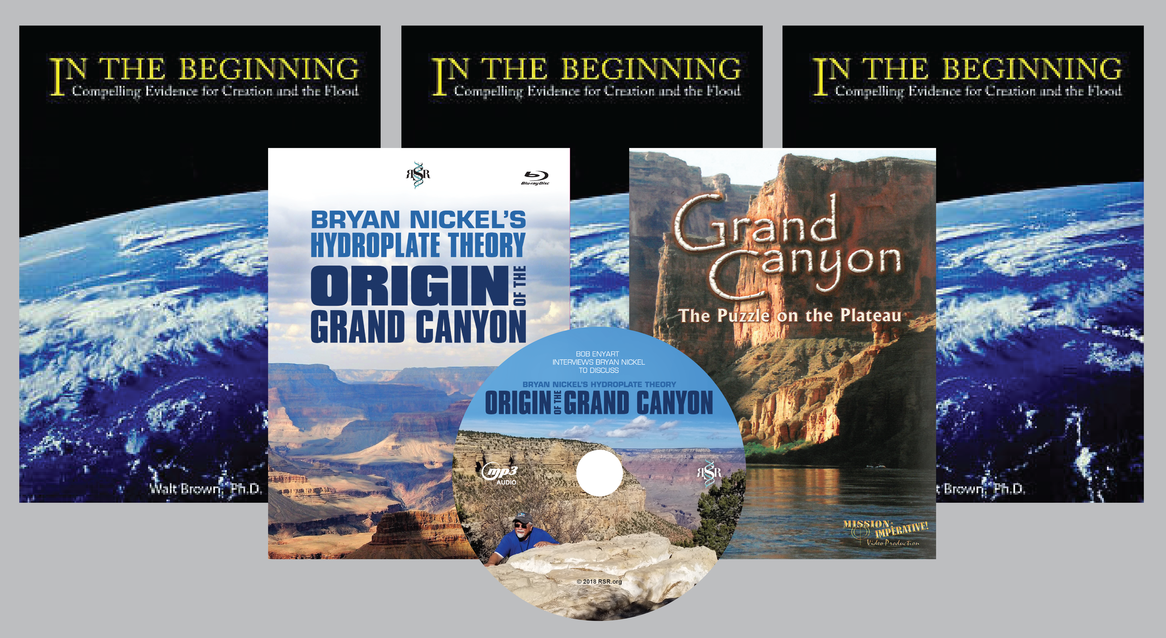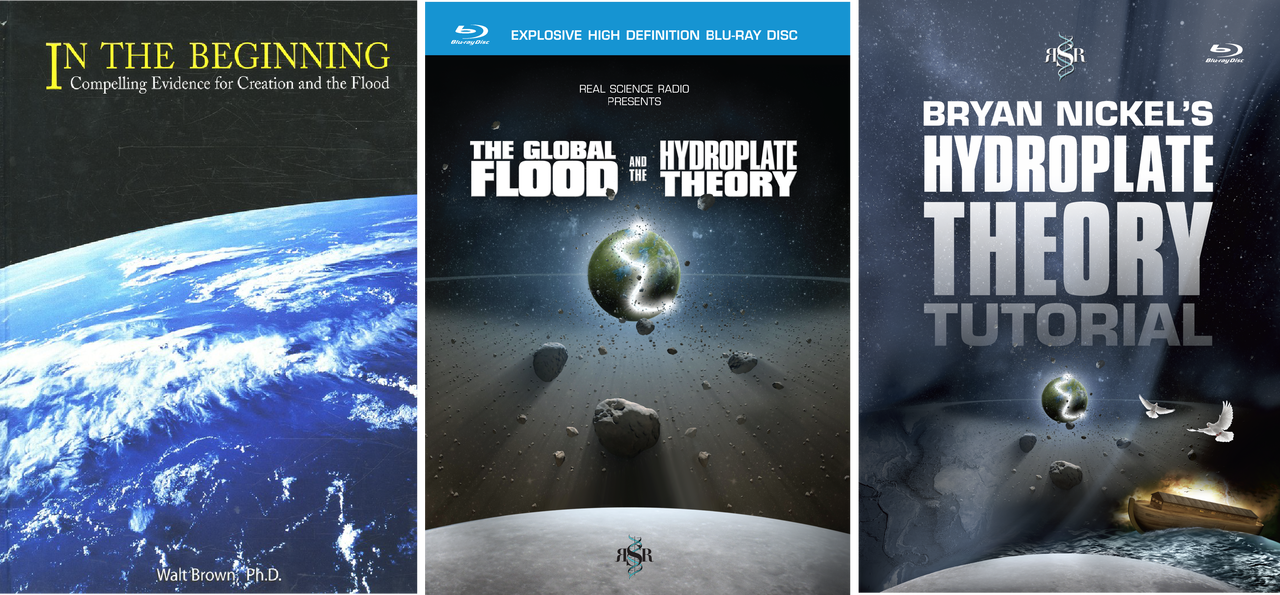
* June is Grand Canyon Month at RSR! Real Science Radio host Bob Enyart concludes with Part 5 his series with Bryan Nickel. If you Google: origin of the Grand Canyon, you'll see that Dr. Walt Brown's online 18-page explanation is ranked #1 out of a million related websites! Further, because the entire region is unique in the world, we expect, and it turns out to be true, that the same causes that excavated the canyon also explain the many wonders of the region’s many National Parks and geological tourist attractions. So RSR offers our Grand Canyon Special for $100 which includes three of Dr. Brown's In the Beginning books, DVDs of Bryan Nickel's and Mike Snavley's complimentary videos on the origin of the canyon, and an audio disc of this 5-part radio series! Today's program first answers the argument that the now extinct Grand Lake never existed. And then Bob and Bryan present in 18 sequential steps the Grand and Hopi Lakes breached-dams explanation for the Grand Canyon!
* RSR's Grand Canyon Special: Help spread the word, get better informed, and keep us broadcasting by purchasing RSR's $100 Grand Canyon Special, our canyon radio series on disc, two stunning videos, and three copies of Walt Brown's book!

* Where are the Shorelines and Sediments for Walt Brown's Grand Lake? Bob and Bryan respond to the argument from Michael Oard and others that Grand Lake did not exist. For other extinct lakes, such as Missoula and Lake Bonneville, geologists find lakebed sediments and well-defined shorelines etched into the shelves around those lakes. So Grand Lake, they conclude, never existed and therefore could not carve out the Grand Canyon. In reply and presenting much of Dr. Walt Brown's answer to the Grand Lake shoreline question, RSR observes that:
- Missoula and Lake Bonneville, for example, existed for two or more centuries longer than Hopi and Grand Lakes so they had much more time to leave behind evidence of their longstanding waters.
- Missoula and Bonneville and other ancient lakes were situated in geologically stable areas and had more consistent water levels to etch clearer shorelines.
- Grand and Hopi Lakes were subject to the uneven hydraulic lifting of the rising Colorado Plateau. As a result, their water levels were frequently changing.
- Grand and Hopi Lakes, as endorheic (or closed or terminal) basins with no outlets, may have been in a state of filling throughout most of their existence so that a continually rising water level wouldn't leave a strong shoreline.
- The lakebeds for Grand and Hopi were actually tilting, which dramatically shifted changing their shorelines, even when there would otherwise not have been a change in their volumes of water. Just as Yellowstone Lake is tilting today, tilting Grand Lake even just a tenth of a degree would move its shoreline by a few miles and far more than that if the axis of the tilt was far from the lake's center.)
- These two basins forming atop the unstable and rising Colorado plateau would have been rapidly filling throughout their approximately 250-year long histories by heavy post-flood precipitation tending to constantly increase their water levels.
- Less than three centuries after the flood, the sediments below and around the lakes would still be wet and only partially cemented and so, far more vulnerable to typical erosion.
- The exceedingly high energy of the catastrophic draining of these massive great lakes scoured their basins removing much of the lakebed sediments.
- The high water table after the flood resulted in powerful springs erupting from the floor and walls of the basins further eroding away lakebed sediments that would otherwise have been left behind.
- A massive quantity of sediments do remain in the area of the former lakebeds as evidenced by NASA's true-color photographs from space of the terrain showing the same lighter color in the lakes than in the surrounding terrain and the same color and patterns between Hopi Lake, which is more commonly recognized by geologists, and Grand Lake.
- Many cliffs, an unusual number, have been identified around the shoreline of Grand Lake, partly resulting from the powerful springs erupting from the shores and undercutting the steeper slopes of the lake basin, making the cliffs around the lake steeper and more pronounced.
* The Events that Carved the Grand Canyon: Drawing heavily from the Grand Canyon chapter in Dr. Walt Brown's Hydroplate Theory, on today's broadcast Bryan Nickel and Bob Enyart describe the following sequence of events:
- Shallow overflow of the southeast shore of high-elevation Grand Lake
- Fast current formation of hot-tub sized "potholes" atop Echo Cliffs
- The Funnel marks the Grand Lake breach point, 18M x 12M x 2k feet deep
- The weight removed, the Funnel's flat hard Kaibab limestone floor upwarped
- The weight removed, the sedimentary layers arch upward toward the Funnel
- The bending limestone failed in a tension crack called Marble Canyon
- The crack splits the funnel and runs toward both Grand and Hopi Lakes
- Groundwater draining in the arched strata forms the "barbed" side canyons
- The great denudation removal of 1k-feet of upper (Mesozoic) sediment begins
- The sediments eroded included those supporting the 250-foot higher Hopi Lake
- Even higher-elevation Hopi Lake now breaches
- The combined waters of two great lakes rapidly continue the great denudation
- The hardened Kaibab limestone prevents deeper "denudation" erosion
- 3,000 cubic miles of energetic water begin carrying sediment to the Gulf of California
- Sudden removal of weight causes rapid hydraulic lifting of the Kaibab Plateau
- Rapid lifting of the plateau causes another Kaibab limestone tension crack
- Torrential floodwaters excavate sediments from below the split Kaibab
- The rapidly falling water levels causes powerful springs to erupt into the basins
- Springs from below and around the lakes erode hundreds of riverless canyons
- Powerful escaping groundwater carves slot canyons, goosenecked drainage, etc.
- Springs carve Canyonlands, Coal Mine Mesa, Monument Valley, Canyon De Chelly
- A massive volume of groundwater adds to the catastrophic dam breach waters
- Continued magma pumping under Kaibab lets Colorado mountains sink further
- Denudation enables magma pool below to continue raising the Kaibab
- The Kaibab Plateau rises until it bends sufficiently to crack its limestone
- The rushing waters follow the crack in the Kaibab Limestone to the northwest
- Combined Hope and Grand Lake breach waters begin carving the Grand Canyon
- Strata arch up over hours and days rebounding from the great denudation
- Canyon excavation exposes a quartzite Block that deformed once soft strata
- The denudation mass loss causes North Rim to rise 1,000 feet higher than south
- Area faults perpendicular to the canyon provide paths for groundwater drainage
- Catastrophic draining of post-flood saturated groundwaters carve the side canyon
- The north side canyons greatly lengthen due to energy in elevated groundwater
- Breach waters sweep away debris from the nearly mile-deep side canyons
- Erosion in the main canyon runs so deep that the granite basement rock is exposed
- Isostatic rebound causes the emerging canyon floor to bow upward
- A tension crack in the upward bending crystalline canyon floor forms the Inner Gorge
- The gorge crack travels for 46 miles but not beyond the upward that caused the tension
- The gorge's erosion-resistant 1-000-foot crystalline walls remain sharp and jagged
- Sediments deposited west of the Canyon to the Gulf include fields of large boulders
- 3,000 cubic miles of energetically dispersed sediments hit the northern Gulf of California
- Final lake and groundwaters dissipate leaving behind the canyon and a drainage system
- Drainage of normal precipitation forms the Colorado River
- The relatively small river has been depositing a relatively small delta now for 5,000 years.

* RSR's Grand Canyon HPT Series:
- List of Problems with ‘The River Carved the Canyon’
- List of Problems with the Canyon’s Millions of Years
- List of Problems with ‘The Flood Carved the Canyon’
- List of the Initial Conditions that Preceded the Canyon
- The Hydroplate Theory Explanation for the Grand Canyon (this show)
- Bonus material: (All part of rsr.org/hpt#metaseries)
Dr. Walt Brown's Canyon RSR Interview
Answering Michael Oard's Missing Grand Lake Shoreline
Answering Don DeYoung's Lawsuit Accusation
Debrief: RSR's Field Trip to the Canyon with Walt
* Radio Broadcast History! Never before has a radio broadcast described, in such detail and so vividly that listeners could see the events unfold in their minds, the origin of the Grand Canyon. By purchasing RSR's $100 Grand Canyon Special, which includes our canyon radio series on disc, two stunning videos, and three copies of Walt Brown's book, you will be helping by spreading the word, getting better informed, and keeping us broadcasting! (Or, consider our HPT Special.)
* The Hydroplate Theory Special: You may want to purchase this set of resources if...
1) You'd like to read the best creation book ever written and watch its accompanying videos
2) You like Real Science Radio and want to help it stay on the air
3) You'd like to give the gift of understanding creation and the flood to someone who could really benefit from it.
* Want to Go from Geology to Cosmology? Here's RSR's latest science video:

